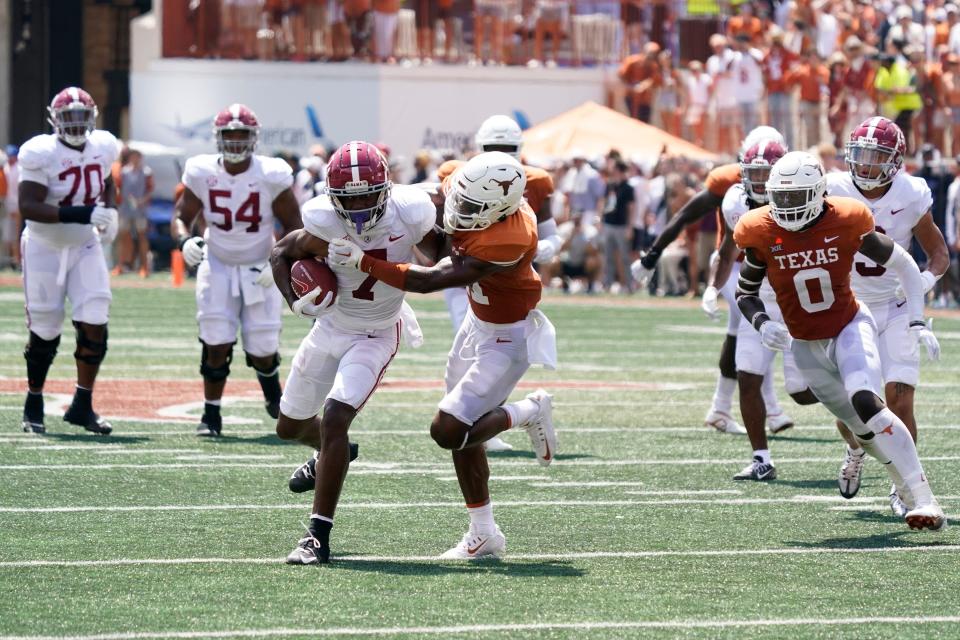Why Nick Saban has Texas on his brain one year before Longhorns join SEC
Nick Saban praised Texas football after the Longhorns pushed Alabama to its limit last September.
“This is like playing an SEC game on the road,” Saban said after the Crimson Tide’s 20-19 escape in Austin.
Months later, Texas remained on Saban’s brain. This time, it wasn’t the school's football performance but rather its finances that attracted his attention.
“The way Southern Cal, Texas and Texas A&M are spending money … what are you willing to spend?” Saban pondered aloud at the SEC spring meetings.
Alabama can’t afford to spend like Texas. Almost no school can.
Texas and Oklahoma will begin competing in the SEC in 2024. Financially, they’re well-positioned to transition into a conference that performs like a heavyweight on the field and at the till.
Oklahoma's annual athletics revenue in the past several years resembles that of an SEC school like Auburn, Florida or LSU. And Texas remains among the NCAA’s richest athletic departments.
Texas, for the fiscal year ending in June 2022, ranked No. 2 nationally in total operating revenue and total operating expenses among public institutions, according to data compiled by USA TODAY Sports in partnership with the Knight-Newhouse Data project at Syracuse University. The annual database published Wednesday.
MONEY MATTERS: SEC, Big Ten each top $2 billion in school athletic revenues
SPRING POWER RANKINGS: Big Ten | SEC | Big 12 | ACC | Pac-12
Texas trailed only Ohio State in both earnings and spending, but the Buckeyes bankroll 33 NCAA sports, compared to Texas' 20 sports.
The Longhorns earn big, they spend big, and, unlike their inconsistent football performance since their 2005 team won the national championship, Texas is an uninterrupted financial juggernaut.
Since USA TODAY began charting athletics finances in 2005, Texas has ranked No. 1 or No. 2 nationally among public schools for operating revenue in all but two years – 2020 and 2021. COVID affected finances in those years, but Texas has returned to its cash-generating ways.
Texas’ $239.3 million in 2022 revenue exceeded the top-dollar SEC school (Alabama) by nearly $25 million. Among its whopper figures, Texas reported $74.9 million in contributions (No. 1 nationally) and $57.5 million in ticket sales (No. 2 nationally).

See Texas make money. See Texas spend money.
Texas’ total operating expenses ($225.2M) outpaced Alabama’s by nearly $30 million.
Only Ohio State and LSU outspent Texas in coaching salaries for 2022, and the Longhorns ranked fourth in administrative and support staff spending.
Deep-pocketed athletic departments enjoy a leg up on the paupers. Texas won the Directors' Cup in 2021 and 2022 for its across-the-board athletics performance.
Now, more than ever, dollars wield influence in college sports. Beginning in 2021, athletes are allowed to profit off their fame and talents through NIL deals. An athletic department cannot directly fund NIL deals, but school-associated collectives are a major player in NIL.
Collectives pool resources from fans and boosters. It’s reasonable to think that a program whose fans and boosters historically uplift it to a high perch also stands to gain an edge in NIL collective fundraising.
Subscribe to SEC Football Unfiltered
iTunes | Google Play | Spotify
SEC invites Big 12’s cash cows
No Big 12 school other than Texas and Oklahoma ranked in the top 30 nationally for 2022 operating revenue. Although Oklahoma doesn't attain Texas-sized figures, its revenue ranked in the top 12 nationally in each of the past 14 years.
The Big 12’s average per school revenue distribution had been millions less of the SEC’s average distribution. Thanks to new media rights deals, the SEC and Big Ten are poised to further pull ahead financially.
Texas reaps financial rewards from the ESPN-operated Longhorn Network, which launched in 2011 and generates an average annual royalty of $15 million for theschool. The network will cease operation when Texas departs the Big 12, but both Texas and Oklahoma should benefit, long-term, from a seat at the SEC’s revenue-sharing table.
In other words, Oklahoma and Texas should remain revenue giants in the SEC.
How revenue translates to football success
All that cash doesn’t guarantee success. In the past 10 seasons, Texas' record is inferior to Missouri's.
Texas A&M, like Texas, is a revenue titan, but the Aggies’ last football national championship came in 1939. Nonetheless, the Aggies’ conference record in the SEC is superior to their Big 12 record, making them a precedent as a well-heeled program that elevated performance after a conference switch.
Texas is widely considered a college football sleeping giant. The Longhorns' instate recruiting base is an advantage. So are their finances. High earnings aid football success.
No school that ranked in the bottom five for 2022 revenue among the SEC’s 13 public schools has won an SEC Championship in football.
Beginning with 2005 Texas’ national championship, nearly every FBS champion hailed from an athletic department whose operating revenue ranked in the top 16 nationally among public institutions during the fiscal year in which it won the national title. Clemson is the exception. Its athletics revenue ranked 26th and 22nd, respectively, when its 2016 and 2018 teams won the national championship.
For the past 15 years, no amount of financing made Texas football perform to the level of the SEC’s elite. Still, Bevo rents space in Saban’s mind. Texas dollars can make the ‘Horns a threat to the SEC’s establishment.
This article originally appeared on USA TODAY NETWORK: Nick Saban, Alabama have Texas on mind with SEC start one year away

